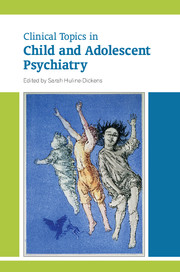Book contents
- Frontmatter
- Contents
- List of tables
- List of boxes
- List of figures
- List of contributors
- Preface
- 1 Child psychiatry and the people who have shaped it
- 2 Fabrication and induction of illness in children
- 3 Personality disorders as disorganisation of attachment and affect regulation
- 4 Post-traumatic stress disorder and attachment: possible links with borderline personality disorder
- 5 Management of antisocial behaviour in childhood
- 6 Pharmacology for attention-deficit hyperactivity disorder, Tourette syndrome and autism spectrum disorder
- 7 Pharmacology for anxiety and obsessive–compulsive disorders, affective disorders and schizophrenia
- 8 Pharmacological management of core and comorbid symptoms in autism spectrum disorder
- 9 Pharmacological treatment of depression and bipolar disorder
- 10 Cognitive–behavioural therapy with children, young people and families: from individual to systemic therapy
- 11 Anxiety disorders
- 12 Somatising: clinical presentations and aetiological factors
- 13 Somatising: management and outcomes
- 14 Evaluating psychological treatments for children with autism
- 15 Attention-deficit hyperactivity disorder: assessment and treatment
- 16 Schizophrenia
- 17 Tourette syndrome
- 18 Sleep disorders
- 19 Self-harm in adolescents
- 20 Adolescent substance misuse: an update on behaviours and treatments
- 21 Eating disorders
- 22 Gender dysphoria in young people
- 23 The psychiatry of children aged 0–4
- Index
16 - Schizophrenia
Published online by Cambridge University Press: 02 January 2018
- Frontmatter
- Contents
- List of tables
- List of boxes
- List of figures
- List of contributors
- Preface
- 1 Child psychiatry and the people who have shaped it
- 2 Fabrication and induction of illness in children
- 3 Personality disorders as disorganisation of attachment and affect regulation
- 4 Post-traumatic stress disorder and attachment: possible links with borderline personality disorder
- 5 Management of antisocial behaviour in childhood
- 6 Pharmacology for attention-deficit hyperactivity disorder, Tourette syndrome and autism spectrum disorder
- 7 Pharmacology for anxiety and obsessive–compulsive disorders, affective disorders and schizophrenia
- 8 Pharmacological management of core and comorbid symptoms in autism spectrum disorder
- 9 Pharmacological treatment of depression and bipolar disorder
- 10 Cognitive–behavioural therapy with children, young people and families: from individual to systemic therapy
- 11 Anxiety disorders
- 12 Somatising: clinical presentations and aetiological factors
- 13 Somatising: management and outcomes
- 14 Evaluating psychological treatments for children with autism
- 15 Attention-deficit hyperactivity disorder: assessment and treatment
- 16 Schizophrenia
- 17 Tourette syndrome
- 18 Sleep disorders
- 19 Self-harm in adolescents
- 20 Adolescent substance misuse: an update on behaviours and treatments
- 21 Eating disorders
- 22 Gender dysphoria in young people
- 23 The psychiatry of children aged 0–4
- Index
Summary
Schizophrenia is one of the most devastating psychiatric disorders to affect children and adolescents. Although extremely rare before the age of 10, the incidence of schizophrenia rises steadily through adolescence to reach its peak in early adult life. The clinical severity, impact on development and poor prognosis of child- and adolescent-onset schizophrenia reinforce the need for early detection, prompt diagnosis and effective treatment.
The current concept of schizophrenia in children and adolescents evolved from a different perspective held during much of the 20th century. Until the early 1970s, the term childhood schizophrenia was applied to children who would now be diagnosed with autism. Kolvin's landmark studies distinguished children with early-onset (autistic) symptoms beginning in the first 2 years of life from children with a relatively ‘late-onset’ psychosis with onset of symptoms after age 6 or 7, which closely resembled adult schizophrenia (Hollis, 2008). Importantly, in ICD-9 (1978) and DSM-III (1980) the separate category of childhood schizophrenia was removed, and the same diagnostic criteria for schizophrenia were applied across the age range. The validity of the diagnosis of schizophrenia in childhood and adolescence is supported by follow-up studies into adulthood that show a high level of diagnostic stability (Hollis, 2000).
This chapter focuses on children and young people who meet ICD- 10 (World Health Organization, 1992) or DSM-5 (American Psychiatric Association, 2013) diagnostic criteria for schizophrenia. I use the term ‘adolescent schizophrenia’ as short-hand to refer to child and adolescent cases with onset up to 17 years of age. I examine evidence for continuities and discontinuities between adolescent schizophrenia and adultonset schizophrenia in terms of aetiology, premorbid features, clinical presentation, course and outcome, and treatment response. My goal is to summarise what is currently known about adolescent schizophrenia and to indicate the extent and limitations of the evidence base for clinical diagnosis, management and treatment.
Epidemiology
Incidence and prevalence
Gillberg et al (1986) calculated age-specific prevalences for all psychoses (including schizophrenia, schizophreniform disorder, affective psychosis, atypical psychosis and drug psychoses) using Swedish case-register data on 13- to 18-year-olds with psychotic illnesses. In 41% of cases the diagnosis was schizophrenia. At 13 years of age, the prevalence for all psychoses in the general population was 0.9 per 10 000, showing a steady increase during adolescence, reaching a prevalence of 17.6 per 10 000 at age 18 years.
- Type
- Chapter
- Information
- Clinical Topics in Child and Adolescent Psychiatry , pp. 246 - 261Publisher: Royal College of PsychiatristsPrint publication year: 2014



